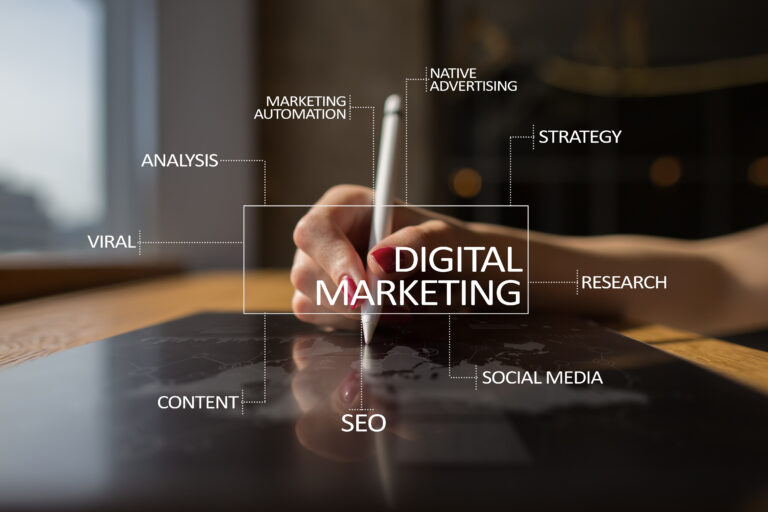Have you ever wondered how websites appear at the top of search engine results? Or how businesses manage to drive targeted traffic to their websites? The answer lies in the world of digital marketing, particularly in three powerful strategies: SEO, SEM, and PPC. In this article, we will delve into the fundamentals of these strategies and explore their role in digital marketing success.
The Fundamentals of Digital Marketing
Digital marketing encompasses a vast array of techniques aimed at promoting products or services online. It involves leveraging various digital channels to reach and engage a target audience. At its core, digital marketing aims to drive traffic, leads, and sales to a business website.
One of the key aspects of digital marketing is search engine optimization (SEO). SEO involves optimizing a website to improve its visibility and ranking on search engine results pages (SERPs). This is done through various techniques such as keyword research, on-page optimization, and link building. By implementing effective SEO strategies, businesses can increase their organic search traffic and attract more potential customers.
In addition to SEO, search engine marketing (SEM) is another crucial component of digital marketing. SEM involves promoting a website through paid advertising on search engines. This is typically done through pay-per-click (PPC) campaigns, where businesses bid on keywords related to their products or services. When a user searches for those keywords, the ads appear at the top of the search results, increasing visibility and driving targeted traffic to the website.
In addition to SEO, search engine marketing (SEM) is another crucial component of digital marketing. SEM involves promoting a website through paid advertising on search engines. This is typically done through pay-per-click (PPC) campaigns, where businesses bid on keywords related to their products or services. When a user searches for those keywords, the ads appear at the top of the search results, increasing visibility and driving targeted traffic to the website.
PPC advertising, as part of SEM, allows businesses to have more control over their marketing campaigns. With PPC, businesses can set specific budgets, target specific demographics, and track the performance of their ads in real-time. This level of control and flexibility makes PPC a valuable tool for businesses looking to maximize their online visibility and generate immediate results.
The Role of SEO, SEM, and PPC in Digital Marketing
SEO, SEM, and PPC are three pillars of digital marketing that work synergistically to maximize online visibility and improve business performance. While they are interconnected, each strategy serves a specific purpose and requires a unique set of skills and expertise.
SEO focuses on optimizing a website’s content, structure, and technical elements to improve its organic search rankings. By targeting relevant keywords and creating high-quality, user-friendly content, businesses can attract organic traffic and establish their authority in their industry. SEO is a long-term strategy that requires continuous monitoring and optimization to stay ahead of competitors and adapt to search engine algorithm updates.
On the other hand, SEM encompasses both SEO and paid advertising. It combines organic search optimization with paid search advertising to maximize visibility on search engine results pages. SEM allows businesses to target specific keywords and demographics, ensuring their ads are shown to the right audience at the right time. By investing in SEM, businesses can drive immediate traffic to their website and increase their chances of converting leads into customers.
PPC, as part of SEM, is a paid advertising model where businesses pay for each click on their ads. This model allows businesses to control their advertising budget and only pay when someone interacts with their ad. PPC campaigns can be highly targeted, allowing businesses to reach specific demographics and geographical locations. With proper keyword research and ad optimization, businesses can achieve a high return on investment (ROI) and generate qualified leads.
In conclusion, SEO, SEM, and PPC are essential components of digital marketing that work together to improve online visibility, attract targeted traffic, and drive business growth. By understanding the role of each strategy and implementing them effectively, businesses can stay competitive in the digital landscape and achieve their marketing goals.
Diving into Search Engine Optimization (SEO)
Search Engine Optimization, or SEO, is the process of optimizing a website to improve its visibility in search engine results pages (SERPs). By implementing various techniques, SEO aims to increase organic, non-paid, and targeted traffic to a website.
When it comes to online visibility, SEO plays a crucial role in ensuring that a website stands out among the millions of other websites competing for attention. In today’s digital age, most internet users rely heavily on search engines to discover information, products, and services. Therefore, ranking high on search engines is essential for online success.
Mastering SEO techniques allows businesses to ensure that their websites appear prominently in search results, driving valuable organic traffic. By optimizing a website’s visibility, businesses can increase their chances of reaching potential customers and achieving their online goals.
The Importance of SEO in Online Visibility
With the ever-increasing number of websites on the internet, the competition for online visibility has become fierce. It is no longer enough to simply have a website; businesses need to take proactive steps to ensure that their websites are easily discoverable by search engines.
SEO serves as a powerful tool in achieving online visibility. By implementing effective SEO strategies, businesses can improve their website’s ranking on search engine result pages. This, in turn, increases the chances of their website being seen by potential customers who are actively searching for products or services related to their industry.
Moreover, appearing on the first page of search results is crucial for businesses as most users rarely venture beyond the first few results. By investing in SEO, businesses can secure a prominent position on search engine result pages, significantly increasing their chances of attracting organic traffic and potential customers.
Key Elements of SEO
SEO comprises various elements that work together to enhance a website’s visibility and ranking on search engines. These elements include:
- Keyword Research: Conducting thorough keyword research helps businesses identify the most relevant and high-performing keywords to target in their SEO efforts. By understanding what keywords potential customers are using to search for products or services, businesses can optimize their website’s content accordingly.
- On-Page Optimization: On-page optimization involves optimizing various elements within a webpage, such as meta tags, headings, and content, to make it more search engine-friendly. By following best practices for on-page optimization, businesses can improve their website’s relevancy and visibility in search results.
- Website Structure: A well-structured website with clear navigation and organized content not only enhances user experience but also improves search engine crawling and indexing. By ensuring that their website is easy to navigate and understand, businesses can improve their chances of ranking higher in search results.
- Quality Content: Creating high-quality, informative, and engaging content is crucial for SEO success. Search engines value websites that provide valuable information to users. By consistently producing quality content that aligns with user intent, businesses can attract organic traffic and establish themselves as authoritative sources in their industry.
- Backlink Building: Building high-quality backlinks from reputable websites is an essential aspect of SEO. Backlinks serve as endorsements for a website’s credibility and relevance. By acquiring relevant and authoritative backlinks, businesses can improve their website’s authority and visibility in search results.
- Technical SEO: Technical SEO involves optimizing a website’s technical aspects, such as site speed, mobile-friendliness, and crawlability. By ensuring that their website meets technical SEO requirements, businesses can provide a seamless user experience and improve their website’s visibility in search results.
By carefully optimizing these key elements of SEO, businesses can enhance their website’s visibility, attract targeted organic traffic, and increase their chances of being found by potential customers. Implementing effective SEO strategies is a continuous process that requires ongoing monitoring, analysis, and adaptation to stay ahead of the competition in the ever-evolving digital landscape
Exploring Search Engine Marketing (SEM)
Search Engine Marketing, or SEM, is a digital marketing strategy that involves promoting websites by increasing their visibility in search engine results pages through both paid advertising and organic efforts.
SEM is a dynamic and ever-evolving field that plays a crucial role in the success of online businesses. It combines various techniques and strategies to drive targeted traffic and increase brand visibility in the competitive digital landscape.
Let’s delve deeper into the fascinating world of SEM and explore its scope, working mechanisms, and the multitude of benefits it offers to businesses.
Understanding the Scope of SEM
SEM encompasses a broader spectrum of tactics, including Search Engine Optimization (SEO), Pay-Per-Click (PPC) advertising, and other search engine-related activities. While SEO focuses primarily on optimizing websites to rank higher organically in search results, SEM goes beyond that by incorporating paid strategies to drive targeted visitors to a website.
PPC advertising, a key component of SEM, allows businesses to bid on specific keywords relevant to their products or services. When users search for these keywords, the businesses’ ads are displayed prominently on search engine results pages, increasing the chances of attracting potential customers.
Furthermore, SEM also includes other techniques such as display advertising, remarketing campaigns, and social media advertising. These strategies enable businesses to reach their target audience across various online platforms, maximizing their visibility and potential customer reach.
How SEM Works
In the world of SEM, businesses create online campaigns that target specific keywords and demographics. These campaigns can include text ads, display ads, and remarketing campaigns, among others. By carefully selecting and bidding on relevant keywords, businesses can display their ads on search engine results pages or other affiliated websites, effectively reaching users who are actively searching for their products or services.
One of the key advantages of SEM is its ability to provide businesses with instant visibility and measurable results. Unlike traditional marketing methods, SEM allows businesses to track and analyze their campaign performance in real-time. This valuable data helps businesses make informed decisions, optimize their strategies, and achieve better ROI.
Moreover, SEM offers businesses the flexibility to target specific demographics, locations, and even the time of day when their ads are displayed. This level of precision targeting ensures that businesses reach the right audience at the right time, increasing the chances of conversions and sales.
As search engines continue to evolve and user behavior changes, SEM professionals constantly adapt their strategies to stay ahead of the curve. They conduct thorough keyword research, analyze market trends, and optimize campaigns to ensure maximum effectiveness and competitiveness in the online landscape.
In conclusion, SEM is a powerful digital marketing strategy that combines organic and paid efforts to enhance website visibility, attract targeted traffic, and drive business growth. By leveraging the vast potential of search engines and implementing effective SEM strategies, businesses can establish a strong online presence, outshine their competitors, and achieve long-term success.
Pay-Per-Click Advertising (PPC) Explained
PPC advertising is a digital marketing model where advertisers pay each time a user clicks on their ads. It is a cost-effective way to drive targeted traffic to a website, as businesses only pay for actual clicks.
The Concept of PPC Advertising
In PPC advertising, businesses bid on specific keywords, and their ads are displayed alongside search results or on relevant websites. When a user clicks on the ad, the business is charged a predetermined amount. With proper optimization, businesses can achieve high conversion rates and maximize their return on investment (ROI).
Benefits of PPC for Businesses
PPC offers several advantages for businesses looking to increase their online visibility and drive immediate results. It allows businesses to target specific keywords and demographics, reach a wider audience, increase brand visibility, and track and measure campaign performance.
SEO vs SEM vs PPC: What's the Difference?
The terms SEO, SEM, and PPC are often used interchangeably, but they represent distinct strategies with different objectives.
Comparing and Contrasting SEO, SEM, and PPC
While SEO and SEM both improve a website’s visibility in search results, SEO focuses on organic traffic, while SEM incorporates both organic and paid efforts. On the other hand, PPC is a subset of SEM, specifically referring to paid advertising campaigns. Each strategy has its own merits and should be approached strategically based on business goals and resources.
Choosing the Right Strategy for Your Business
Deciding on the most suitable digital marketing strategy depends on various factors, including budget, competition, and marketing goals. Businesses must carefully evaluate their objectives and resources to determine which approach will yield the best results.
Factors to Consider When Choosing Between SEO, SEM, and PPC
When weighing the options, consider factors such as long-term vs. short-term goals, initial investment, expected ROI, target audience, and competition. Aligning the chosen strategy with your business objectives will increase the likelihood of achieving digital marketing success.
By understanding the basics of SEO, SEM, and PPC, businesses can leverage these strategies to increase their online visibility, drive targeted traffic, and ultimately boost their bottom line. Keep in mind that digital marketing is ever-evolving, and staying up-to-date with the latest trends and techniques is essential for long-term success. Now that you have a solid understanding of these digital marketing pillars, you can make informed decisions to propel your business forward in the digital arena.





